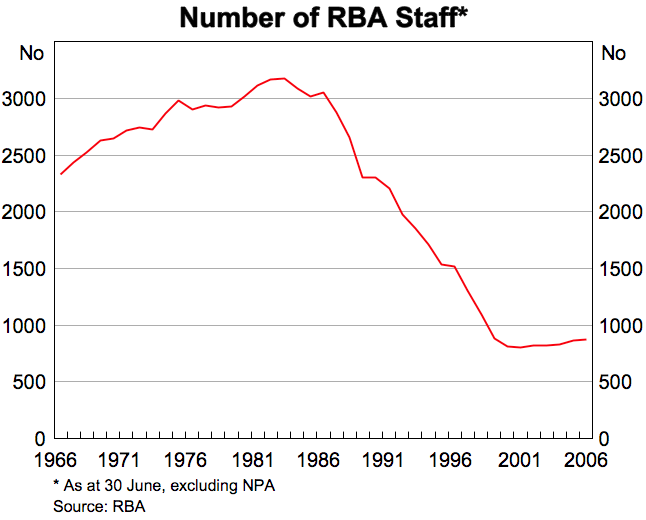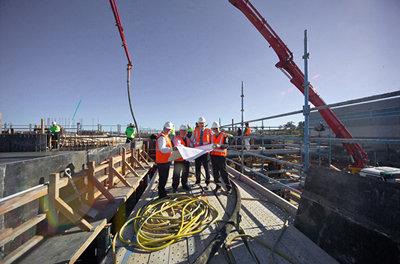Reserve Bank of Australia Annual Report – 2006 Management of the Reserve Bank
Operating Costs
More than half of the Reserve Bank's operating costs are incurred in the core policy areas of monetary policy and financial system stability. The remainder is spread quite evenly across note issue, settlements and banking. Nearly 60 per cent of costs are staff costs.
The Reserve Bank's operating costs rose by about 8 per cent in 2005/06, with some major projects in the core areas of responsibility contributing almost half of the increase. For example, the project to modernise RITS continued, with banks planning to adopt the new system interface by the end of 2006. The new system will enhance user access, and provide greater security and better backup functions. The new features of RITS will ensure that the real‑time interbank gross settlement system in Australia remains abreast of world best practice. Further development of RITS systems is likely over the next few years. New activities to improve the quality of currency notes in circulation raised outlays directly associated with currency distribution, and led to higher depreciation on new note-handling equipment and spending on research activities, as improved systems for currency note evaluation were developed. This project takes advantage of the durability of polymer note technology, which provides the opportunity to maintain generally high‑quality notes in circulation at low long‑term cost. This, in turn, helps contain the threat of counterfeit notes.
Although also raising operating costs, once commissioned in mid 2007, the business resumption site (BRS) will ensure that the Reserve Bank's critical functions will continue to operate if access to Head Office systems or accommodation is lost. In particular, the facility will provide continuity for RITS, banking operations for the Australian Government – such as those for making pension and health care payments – and the Reserve Bank's market operations. This project will strengthen the financial system infrastructure in Australia and is in line with steps being taken by banks and central banks around the world to cope with disruption to their activities. The fact that the Reserve Bank assumed management of the facility used by NPA at Craigieburn also raised the Bank's direct costs in 2005/06, although it resulted in lower overall costs on a consolidated basis, as it led to savings in staff costs at NPA. Over time, further cost reductions are expected as the Reserve Bank applies its procurement practices to servicing the NPA site. These services are provided to NPA on a cost‑recovery basis.
| 1997 /98 |
1998 /99 |
1999 /00 |
2000 /01 |
2001 /02 |
2002 /03 |
2003 /04 |
2004 /05 |
2005 /06 |
|
|---|---|---|---|---|---|---|---|---|---|
| Staff costs | 77.7 | 69.1 | 68.7 | 67.7 | 73.9 | 77.8 | 85.5 | 91.4 | 100.5 |
| Other costs | 47.2 | 49.1 | 56.1 | 54.1 | 58.4 | 62.7 | 58.6 | 68.8 | 73.1 |
| Underlying operating costs |
124.9 | 118.2 | 124.8 | 121.8 | 132.3 | 140.5 | 144.1 | 160.2 | 173.6 |
| Cost of redundancies |
20.7 | 18.4 | 9.3 | 2.6 | 3.4 | 2.6 | 0.2 | 0.2 | 0.2 |
| (a) Costs associated with the ongoing operation of the Reserve Bank, excluding NPA. | |||||||||
The rise in staff costs in 2005/06 reflected an annual increase in base salaries of 4 per cent in November 2005, plus some performance payments. Average staff levels in 2005/06 were about 2 per cent higher than those in the previous year. In policy areas, this reflected the annual program of recruiting graduates of suitable quality in disciplines related to the Reserve Bank's policy responsibilities and the appointment of a couple of more senior economists with overseas experience. Small staffing increases were associated with the work on currency note quality, while staff with specialist skills were appointed, usually on short‑term contracts, to assist with designing IT systems for the BRS and other smaller projects. Staff costs were also affected by the decision early in 2006 to restore, on actuarial advice, contributions to the staff superannuation fund to a more normal long‑term rate, after contributions had previously been made at significantly lower rates over a long period, also on actuarial advice.
Staff costs have been rising in recent years, but remain slightly below their peak level of 1990/91. The rise in staff numbers from the historically low point of 2001, when total staff was about a quarter of its peak in 1983, reflects a number of factors: RITS operations were relocated to the Reserve Bank from an external provider to ensure that resources would be applied to maintain the system at a high level of performance; the regional offices were established in Melbourne, Brisbane, Perth and Adelaide; the Reserve Bank's international responsibilities have expanded and been staffed accordingly; IT systems, including support for Internet facilities, have increased; and the risk management function has been established, with more staff also appointed in internal audit. Staff numbers have recently been boosted temporarily by short‑term contractors working on projects. Annual salary increases, within successive enterprise bargaining agreements, have ranged between 3½ and 4 per cent since 2001. In real terms, staff costs remain a little more than half their peak in 1987.
Staffing
The Reserve Bank's responsibilities require high-calibre staff. Over half of the staff have degree qualifications and a fifth have post‑graduate qualifications. A number of programs support the Reserve Bank's aim of recruiting professional staff of suitable quality. Honours graduates are sought through the Cadetship Scheme, which provides students of high potential in relevant disciplines with work experience at the start of their honours year. Financial support during that year is available if cadets are offered, and accept, a place on the next Graduate Development Program. Business Sponsorships have also been used during the year to attract a small number of experienced economists from overseas.
Financial support is provided to current staff for part‑time study in disciplines related to their work; at the end of June 2006, 80 employees were studying part‑time. For a few of the most capable staff, financial assistance is provided for full‑time post‑graduate study at universities in Australia and overseas; in the past year, nine staff received such assistance. Staff who are supported for full‑time study are required to reimburse these costs if they resign either while studying or before completing an agreed period of work after returning from study.

A number of informal and formal training programs aim to develop workplace skills and management expertise. The performance appraisal process encourages supervisors and managers to plan appropriate training for their staff. Professional development is encouraged through secondments, either to the Reserve Bank's regional and overseas offices or to other organisations. During 2005/06, staff have worked at the BIS, the Bank of France, the Australian Treasury, the Australian Taxation Office, ASIC and the Financial Services Authority in the UK. Staff are often seconded within the Reserve Bank to participate in projects of various kinds, which draw together skills from a range of disciplines, resulting in a better appreciation of the variety of challenges facing staff working in different areas.
Eighty per cent of staff in professional and managerial roles are employed on individual contracts, which provide flexibility to match remuneration with accountability and performance. At executive levels, these contracts are for five‑year fixed terms and vacancies are advertised both within and outside the Reserve Bank. External remuneration benchmarking for staff is facilitated by a program of formal job evaluations, advice from remuneration consultants and participation in industry-based salary surveys.
The terms of employment for staff not employed on individual contracts continue to be determined by the current enterprise bargaining agreement (EBA). This agreement provided for an annual salary increase of 4 per cent in November 2005, and continues to provide greater scope than in the past to reward good performance, within the existing budget. It also provided for more efficient work practices in a number of areas while accommodating more flexible work arrangements, especially for staff with caring responsibilities. Staff on individual contracts received, on average, the same annual salary increase as staff covered by the EBA. The Reserve Bank is currently reviewing recent changes to workplace legislation and considering the appropriate industrial instruments for 2007 and beyond.
Benefits provided to staff are kept under review to ensure that they remain consistent with the contemporary needs of staff. Twelve parents currently use one or more of the 20 places available at the Reserve Bank's joint‑venture childcare facility, established in the Sydney CBD in early 2005. Several others will take up positions in coming months.
The Reserve Bank continues to participate in the Australian Government's New Apprenticeship and Traineeship System, which provides training in a number of areas to young people who generally lack a widely recognised post‑school qualification.
Facilities Management
The Reserve Bank owns property in locations in which it has a business need, including office accommodation in the CBDs of Sydney, Melbourne and Canberra and the site at Craigieburn, north of Melbourne, where NPA, the NNPDC and Securency are located. Surplus space in the CBD premises is leased to tenants on commercial terms. With virtually this entire surplus remaining fully leased during the year, gross annual rental income amounted to $6.3 million.
Following Parliamentary approval in June 2005, expressions of interest and tenders were called for the construction of the BRS in outer metropolitan Sydney. When completed, the site will provide accommodation for staff and IT systems to ensure continuity for the Reserve Bank's critical business functions if there is disruption to these activities at Head Office. The construction contract was awarded to Grindley Construction Pty Ltd in January 2006, with work commencing on site early in February. The project is on program for completion by the end of March 2007, within the overall project budget of $38 million. The facility is planned to be ready for operations in July 2007, following commissioning of IT and communications systems. In addition, during the year work commenced to strengthen the Head Office IT and associated electrical infrastructure, compatible with systems planned for the BRS.
The Reserve Bank has established various policies and programs to promote best practice in the areas of environmental management systems and operations. These include the Reserve Bank's Energy Management Program, which has achieved a reduction in energy consumption in accord with Australian Government targets. Other environmental programs focus on recycling and efficient practices to reduce waste. The Reserve Bank's procurement policies are consistent with relevant environmental guidelines.

Consultancies
In common with other large organisations, the Reserve Bank employs outside contractors or professional service providers to carry out specific tasks where necessary, and also, from time to time, uses consultants. A consultant investigates particular issues and then provides independent advice. In 2005/06, the following four consultancies were undertaken.
| Name | Project | Cost ($, excl GST) | Purpose |
|---|---|---|---|
| Castelain Pty Ltd | RITS application | 35,000 | Technical advice on implementation of IT security systems |
| Castelain Pty Ltd | Secure Internet transmission | 49,078 | Technical advice about connecting to Fedlink |
| Clayton Utz | EFTPOS Access Regime reforms | 84,483 | Legal advice on reform of the EFTPOS Access Regime |
| Hay Group Pty Ltd | RBA personnel | 57,200 | Market testing of remuneration of RBA staff |
| (a) Costing $10,000 or more | |||